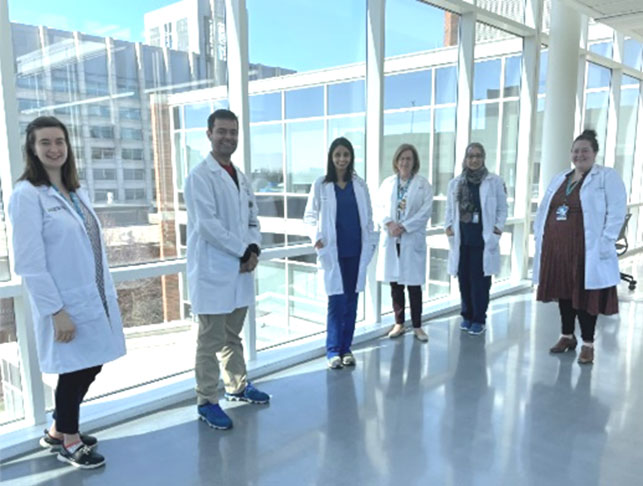“Gold Plus” Advances in Stroke Care at the University of Illinois at Chicago
“Gold Plus” Advances in Stroke Care at the University of Illinois at Chicago Heading link

Stroke is one of the leading causes of disability and mortality worldwide. It has been estimated that approximately 800,000 cases of stroke occur in the United States every year; almost 80 percent of these are first-ever strokes and the rest are recurrent. Large epidemiologic studies have shown that about 90 percent of new strokes are caused by modifiable vascular risk factors. This suggests that the majority of strokes are preventable.
Once a stroke occurs, time is of the essence. Rapid interventions including treatment with a tissue-plasminogen activator (tPA—a protein for blood clot breakdown) or with mechanical thrombectomy (blood clot removal from blood vessels) can improve the chances of recovery and minimize the risk of disability. The University of Illinois at Chicago (UIC) has a track record of accomplishments in stroke research and is a reference center for the treatment of complex stroke cases.
Through the institution of a robust and streamlined “tele-stroke” service, UIC’s footprint in the community has become larger than ever. Currently, the UIC stroke service covers 7 different hospitals in the Chicago area and provides more than one thousand acute “tele-stroke” consultations every year. Furthermore, discussions are ongoing regarding the addition of two centers to the UIC stroke network in the subsequent month. UIC’s clinical efforts have been recognized by the American Heart Association (AHA) and the American Stroke Association (ASA) who have awarded UIC the “Gold Plus Quality Achievement Award” with “Target: Stroke Honor Roll Elite Plus” through the Get With the Guidelines® – Stroke program.
From a research standpoint, 2020 was a productive year for UIC’s Department of Neurology Stroke Section. In addition to participation in different multi-center stroke trials, the stroke section had a dominant role in stroke research. COVID-19 infection has been described as a risk factor for stroke. UIC took the lead in a regional effort to describe the risk factors associated with stroke outcomes in patients with COVID-19. To this end, UIC’s Department of Neurology Stroke Section developed the Stroke-COVID-19-Chicago Consortium. A total of 6 stroke centers from the Chicago area took part in this initiative and the largest cohort of stroke patients with concomitant COVID-19 ever described was generated. Results showed that males (especially those that are black) were more likely to have severe in-hospital complications and worse outcomes after ischemic strokes when compared to females.
Subarachnoid hemorrhage (SAH) is a subtype of stroke that typically affects young individuals and is caused by the rupture of a cerebral aneurysm. Approximately 30% of those who suffer SAH die early after the bleed begins and almost 30% of those who survive experience chronic neurologic complications. These complications can include cognitive impairments or focal neurologic deficits. Through a cohort of individuals with recent SAH, the UIC Department of Neurology Stroke Section demonstrated that approximately half of the patients that report good functional outcomes suffer severe cognitive impairment. This suggests that the effects of SAH on cognition are far more profound than originally suspected and highlights the importance of additional research studies. In a related study, the UIC Stroke Section investigated the role of early inflammation on SAH outcome in an independent cohort of patients. Levels of inflammasome-derived enzyme caspase-1 (an early mediator of inflammation) were measured in the cerebrospinal fluid (CSF) of SAH patients and healthy controls. Inflammasome-derived caspase-1 activity was elevated in the CSF of patients when compared to controls and these levels correlated with worse functional outcomes.
Epidemiological studies suggest that with the extended life expectancy in the United States, the number of strokes between 2010 and 2050 will more than double. It has been forecasted that, of the increasing stroke cases, the majority will occur in the elderly and in underrepresented groups. Hispanics/Latinos, the fastest growing demographic group in the United States, have been shown to have elevated rates of modifiable vascular risk factors (VRFs) and stroke. A group led by UIC’s Dr. Fernando Testai investigated the prevalence, awareness, and control of VRF’s and the use of antithrombotic and statin agents in U.S. Hispanic/Latino adults with histories of stroke/transient ischemic attack (TIA) in the Hispanic Community Health Study/Study of Latinos (HCHS/SOL). The factors influencing the strokes/TIAs were also studied. The data obtained through the study demonstrated that Hispanics/Latinos with histories of previous stroke/TIA had elevated rates of poor habits. As an example, approximately 80% were overweight/obese, 70% had an unhealthy diet, 50% did not meet the goals for physical activity recommended by the American Stroke Association (ASA), and 20% continued to smoke.
Antithrombotic and statin agents are the mainstay in the prevention of recurrent strokes. In the study, approximately 50% of participants with histories of stroke/TIA were on antithrombotic agents, 40% were on statin agents, and 25% were on both. In multivariate analysis, older age was observed to be associated with uncontrolled hypertension and diabetes. In addition, residing in the United States for ≥10 years and being born in the United States were associated with uncontrolled diabetes, uncontrolled dyslipidemia in those of the female sex, and lack of health insurance with decreased use of statins and decreased hyperlipidemia. This study, then, demonstrated that large areas for improvement exist in the implementation of stroke prevention strategies in Hispanic/Latino adults with histories of stroke/TIA. Furthermore, the elderly, individuals with extended residence in the United States, females, and those without health insurance were identified as vulnerable groups that may benefit from targeted interventions.
The efforts and initiative described constituting a summary of the research and clinical endeavors led by the UIC Department of Neurology Stroke Section. Through active collaborations across a variety of disciplines, the Stroke Section will continue to expand the boundaries of knowledge in the stroke field and contribute to the identification of processes that influence outcomes and the development of new treatments.